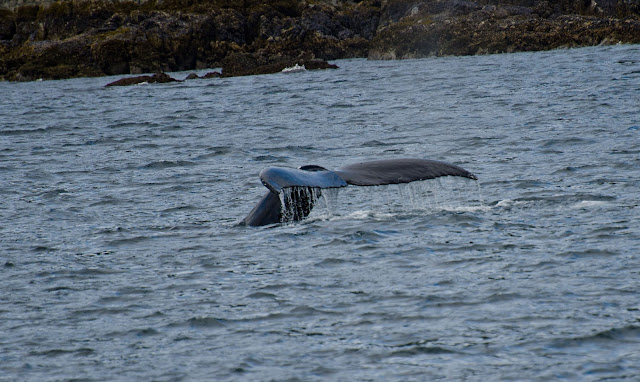OMG – what fun we had!!
We got so much tail!! They were
all humpbacks. The orcas are migratory
and sadly we didn’t see any.
We arrived to a semi-sunny day in Juneau.
Captain Jack met us at the pier and drove us to the other side of town
where his boat was waiting. Joey and
Ryan are the crew on the M/V Scania. As
it turned out, we were the only guests for the day. It’s very early in the season. Later on, his boat will be filled with whale
seekers every day.
We took off and didn’t have to go far before we encountered
the first one. I missed the best photo
op of the day when he flashed us a huge tail right beside the boat. What was I doing? Climbing the ladder to the top level of the
boat – which required both hands on the railing because the boat was rocking
about. And with that flash he was gone. Oh well.
We saw plenty more, just not as close as that first one.
How does one find a whale, anyway? You definitely increase your chances when you
have lots of help. Joey and Ryan were
our spotters, and they were really good.
They continually scanned the area for the “blow”, or the exhalation of
the whales. It looks like the smoke from
a campfire. And if you’re close enough
you can smell it – it reeks like rotten fish.
Captain Jack manned the radio and communicated with all the
other tour guides in the area. Any time
someone spotted a whale, they shared the location. We were able to relocate to new positions
whenever we got word of a sighting. I
was so lucky to get these pictures!
The calves are born in Hawaii in January. The mothers stay there with them until they are
strong enough to travel the 3,000 miles to Alaska.
They come here for the excellent feeding ground. We were fortunate to see this baby and mom…
Captain Jack told us that most literature states the life
expectancy of a humpback is 60 years.
Recent research indicates that it’s more like 150-200 years. They have found whale carcasses with harpoon
barbs dating back that long ago. They
aren’t sure if the bubble netting behavior is something learned recently, or if
the old-timers are bringing back an old practice.
We took a short detour to see a colony of sea lions. They like to hang out here and play “king of
the buoy”. These guys just cracked me
up. Aren't they adorable?
Then we went near shore where the moms give birth. The whole shoreline was packed with
them. They literally crawled over each
other. I noticed one in the water who
was leaping and playing. I happened to
catch this picture, and didn’t realize until I saw it on the screen that his
mouth was open. I think he was laughing
while he played. Can you see the pups on shore?
And we saw the Mendenhall Glacier from the water…
Today was definitely the highlight of the trip. Nature always entertains me. Sadly, we didn't see any whales breech this time. Maybe they'll honor me with that next time.
Stay tuned…










No comments:
Post a Comment